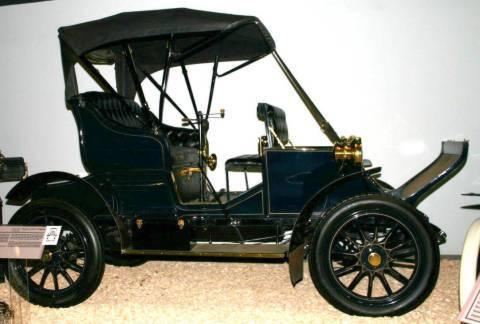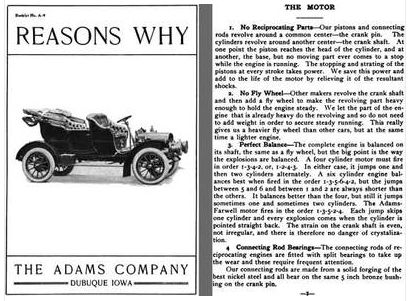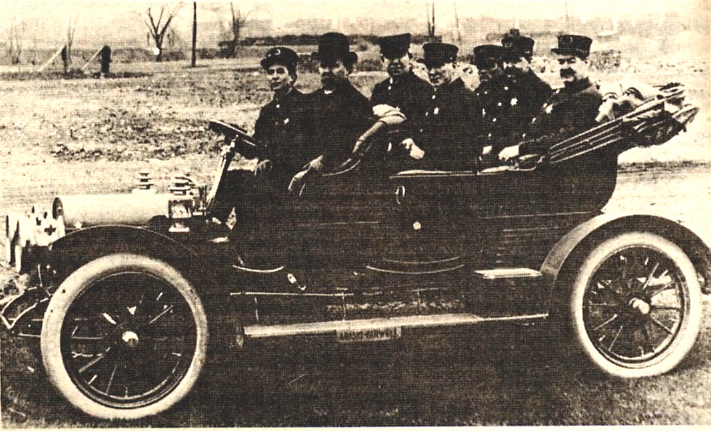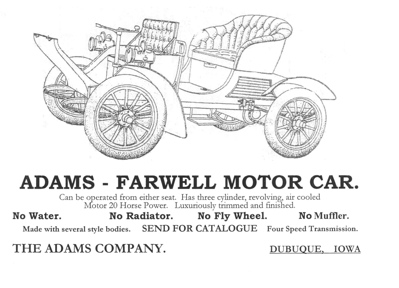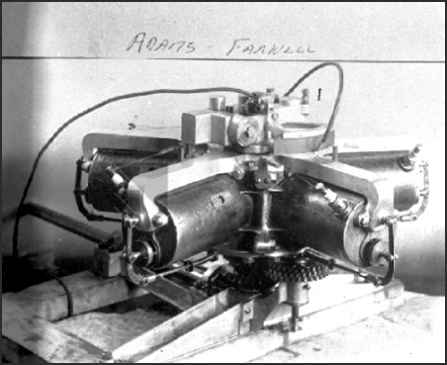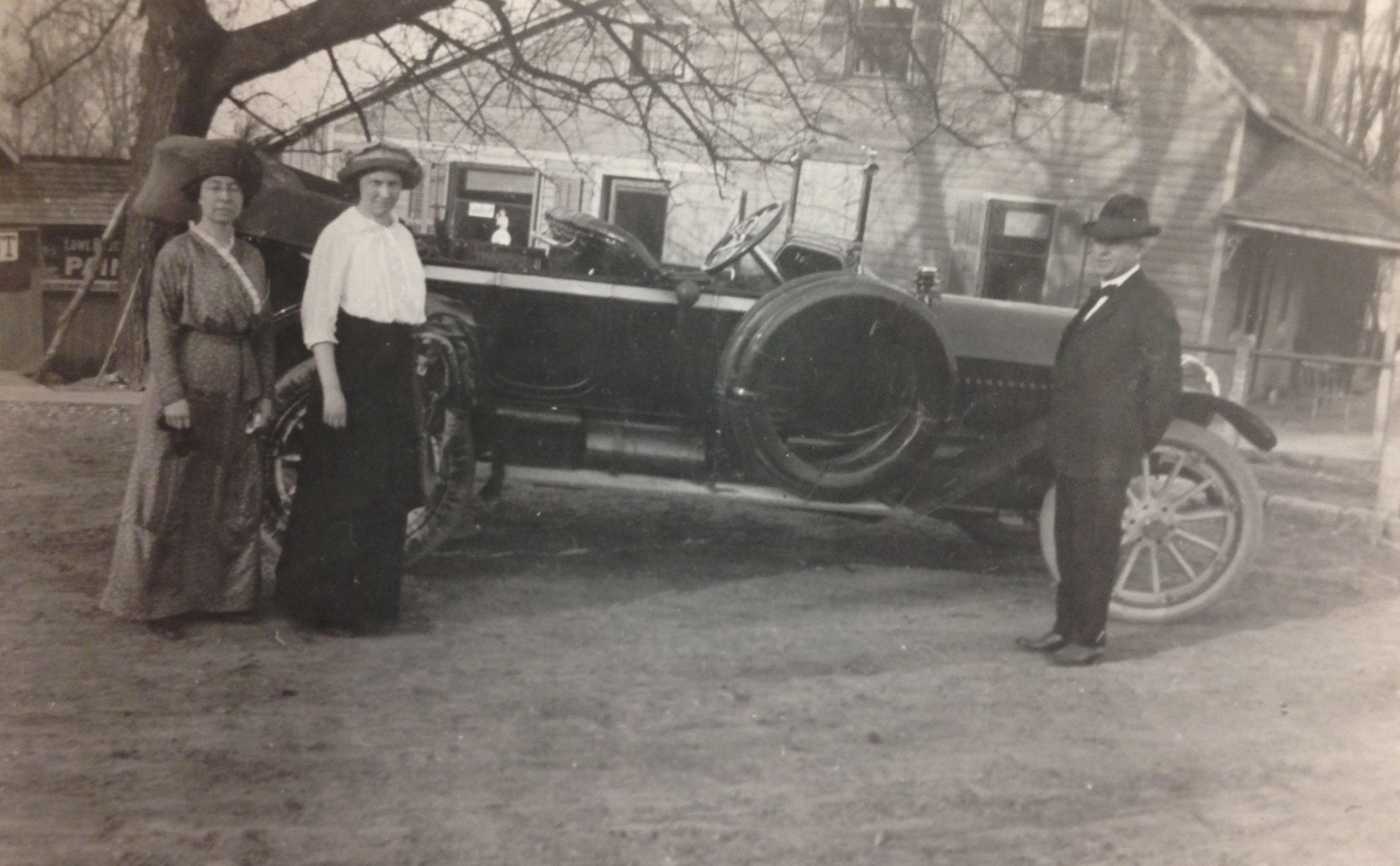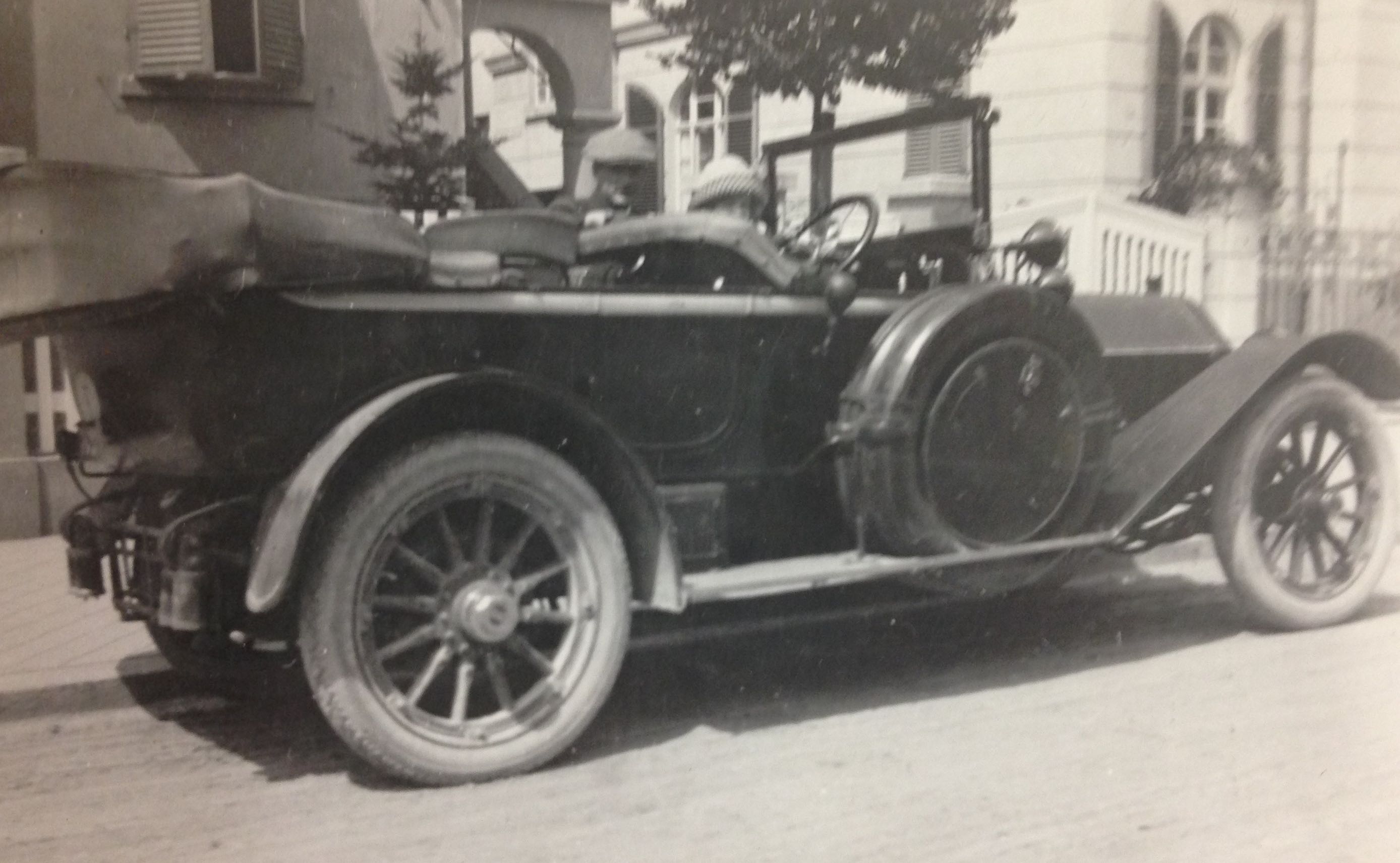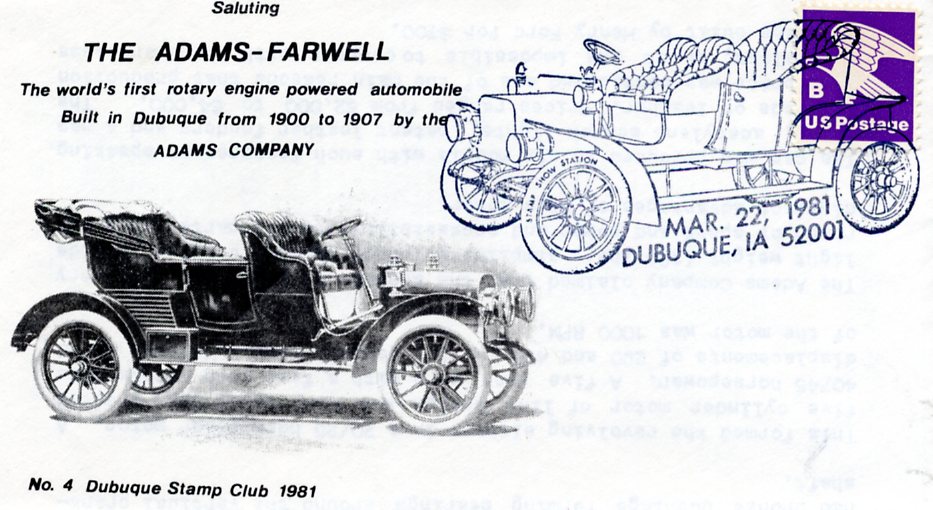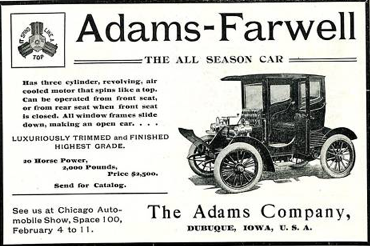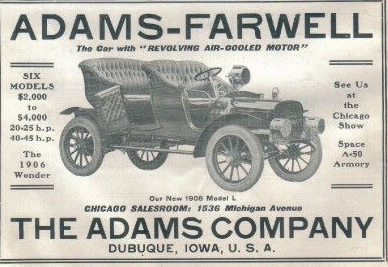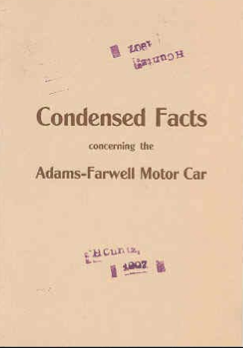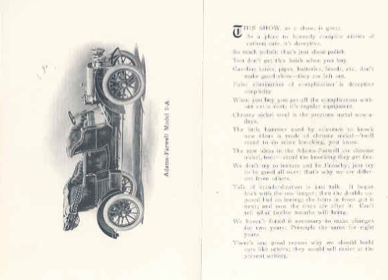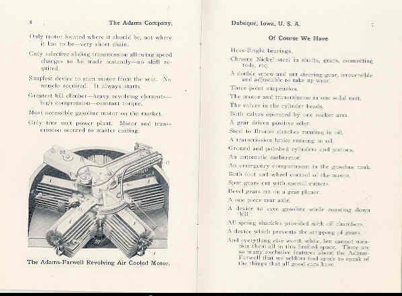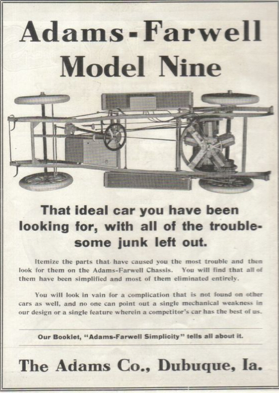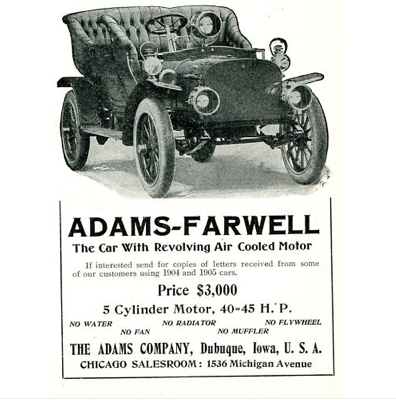Encyclopedia Dubuque
"Encyclopedia Dubuque is the online authority for all things Dubuque, written by the people who know the city best.”
Marshall Cohen—researcher and producer, CNN
Affiliated with the Local History Network of the State Historical Society of Iowa, and the Iowa Museum Association.
ADAMS-FARWELL AUTOMOBILES: Difference between revisions
No edit summary |
No edit summary |
||
| Line 69: | Line 69: | ||
Automobile manufacturing in Iowa lasted between ten and twelve years. Larger companies located in the East constructed factories with assembly lines which allowed the production of cars more cheaply. The Iowa automobile manufacturers, however, share credit with others for the construction of better roads. It was difficult to drive through mud, so gravel was spread to make a better surface. Concrete roads began to appear in 1920 and became expected on major roads by 1930. This led to the development of cement factories near Davenport, Des Moines, and Mason City and the employment of thousands in the new industry. (17) | Automobile manufacturing in Iowa lasted between ten and twelve years. Larger companies located in the East constructed factories with assembly lines which allowed the production of cars more cheaply. The Iowa automobile manufacturers, however, share credit with others for the construction of better roads. It was difficult to drive through mud, so gravel was spread to make a better surface. Concrete roads began to appear in 1920 and became expected on major roads by 1930. This led to the development of cement factories near Davenport, Des Moines, and Mason City and the employment of thousands in the new industry. (17) | ||
Automobile historians long sought an example of an Adams-Farwell car. Making the matter more difficult was the fact that most of the cars had been shipped to other parts of the country. (18) It was not until around 1910 that "the wealthy and more daring purchased automobiles for sporting purposes rather than practical transportation." (19) According to the Bill Jepsen book '''Made in Iowa--Iowa's Automobiles''', Henry Ford was the first person interested in acquiring an Adams-Farwell. He even offered a $500 reward for information leading to one. At the same time, the Chicago Museum of Science and Industry was searching for an example to showcase in its "Golden Jubilee Celebration of the First Automobile Race to be Held in America." (20) Although no Adams-Farwell was involved in the race, it was the only type of American-made automobile not in an American exhibit at the time. (21) | |||
In 1945 careful detective work proved successful. It was discovered that Florida resident Emerson Clavel owned a five-cylinder Model 6A. Clavel later sold his car to D. Cameron Peck who restored and then sold the car to Henry Austin Clark, Jr. of New York. In his research on this automobile, Clark found that it had originally been owned by James Beach of Dubuque. In 1966 this automobile, purchased from Clark in 1963 by the Harrah Automobile Foundation, was completely restored. It was later displayed in Reno, Nevada, at the National Automobile Museum. | In 1945 careful detective work proved successful. It was discovered that Florida resident Emerson Clavel owned a five-cylinder Model 6A. Clavel later sold his car to D. Cameron Peck who restored and then sold the car to Henry Austin Clark, Jr. of New York. In his research on this automobile, Clark found that it had originally been owned by James Beach of Dubuque. In 1966 this automobile, purchased from Clark in 1963 by the Harrah Automobile Foundation, was completely restored. It was later displayed in Reno, Nevada, at the National Automobile Museum. | ||
| Line 75: | Line 75: | ||
On August 21, 2011 the Adams-Farwell won the prestigious Charles A. Chayne Trophy at the Pebble Beach Concours d’Elegance. This trophy is awarded to the car with the most advanced engineering of its era. (22) | On August 21, 2011 the Adams-Farwell won the prestigious Charles A. Chayne Trophy at the Pebble Beach Concours d’Elegance. This trophy is awarded to the car with the most advanced engineering of its era. (22) | ||
History of the Adams-Farwell (23) | History of the Adams-Farwell (23) | ||
| Line 124: | Line 117: | ||
1909-1912 Model 9 5 rotary 50 hp 3251 / 128 7-passenger Touring $3500 | 1909-1912 Model 9 5 rotary 50 hp 3251 / 128 7-passenger Touring $3500 | ||
[[Image:all-season.png|left|thumb|250px|]] | |||
[[Image:adamsf.png|left|thumb|250px|]] | |||
[[Image:adamsfolder.png|left|thumb|150px|Non-color catalog, 4x 6 inches, showing the Model 7A Touring car, one illustration of the engine, and a complete description of the car. The pamphlet was produced by the Adams Company.]] | |||
[[Image:adamsfolder-2.png|left|thumb|250px|Pamphlet contents]] | |||
[[Image:adamsfolder-3.png|left|thumb|250px|Pamphlet contents]] | |||
[[Image:af-2.png|left|thumb|200px|Advertisement]] | |||
[[Image:AF5.png|left|thumb|300px|]] | |||
Revision as of 02:31, 16 September 2016
ADAMS-FARWELL AUTOMOBILES. Between 1898 and 1907, the ADAMS COMPANY (THE) manufactured fifty-two automobiles featuring futuristic innovations including fuel injection, supercharging, and automatic timing. There was even a model capable of 75 miles-per-hour, if a road could be found that could handle such speeds. (1) The car was the first in the world to be powered with an air-cooled ROTARY ENGINE placed in the rear of the car ahead of the axle on a vertical axis. (2)
The Adams-Farwell history began in 1898. Model One, Adams-Farwell's "horseless carriage," was built with an engine designed by Fay Oliver FARWELL, the factory's superintendent and self-taught mechanic. Farwell mounted his engine, which revolved on a vertical axis, on an express wagon. This was to be the only model designed with the engine in the front. Only one car was built.
Model Two, built about 1899, refined the car's appearance, comfort, and design. The single model produced was not offered for sale. The Model Three, built in the fall of 1901, so captured Farwell's interest that in 1903 he added doors, canopy top and a glass windshield. Cars suddenly had potential for year-round use. One of the many unique qualities of the car involved the steering column. The entire assembly and foot pedals could be removed from the front and placed in slots in front of the back seats. This converted the car from a two-seat coupe to a roadster. (3)
By 1903 the chassis for the Adams-Farwell was being produced in Dubuque by the Connolly Carriage and Buggy Company. Started by Thomas CONNOLLY, the company had been a competitor of Augustin A. COOPER in the production of wagons and carriages. In 1910 Adams-Farwell roadster and seven-passenger models were being advertised as having a hard wood frame with metal for "the back of seats and rear door through which access is had to the motor." (4)
The 1904 Adams-Farwell Model Five was powered by a twenty horsepower three-cylinder rotary engine. Acclaim by this time was becoming widespread. Exhibitors at the Chicago Auto Show in February 1905 praised the car for its innovations. The Chicago Chronicle declared of the car, "one of the most attractive cars at the auto show and one which has found perhaps the maximum of purchasers." (5) The same year an Adams-Farwell car posted the best time for any air-cooled entry entered in the Chicago, Illinois, to Minneapolis, Minnesota, auto race. Ironically the driver of the car was named George PICKUP. (6)
In 1906 a new model followed with five cylinders capable of producing forty to forty-five horsepower. With the body constructed locally at the Connolly Carriage and Buggy Company, this model cost $2,500. When James BEACH bought an Adams-Farwell he had difficulty getting a license to drive it because "authorities" in Des Moines did not believe there were any five-cylinder cars. They were wrong. The 1906 Adams-Farwell was available in three-cylinder (25 horsepower) or five-cylinder (45 horsepower) models. (7)
The 1906 Model 6A had the following specifications: (8)
Body: Convertible, open body, folding front seat,
capable of being driven from the front or rear seat
Color: Black with fine blue lines or as desired
Upholstery: leather, curled hair and springs
Seating Capacity: five; three on main seat and two
on folding seat
Equipment: Acetylene search lights, one rear signal
lamp, odometer, gradometer, horn, all necessary
tools
Wheels: 34 inch, artillery
Wheel Base: 84 inches
Wheel Gauge: 56 inches
Tires: 34 x 4 inches
Fenders: Patent leather
Axles: Front--1 3/8 inches solid steel, rear--2 inch
heavy tube
Bearings: Timken roller
Springs: Front--340 x 2 inches, 5 leaves, rear--40X 2
inches, 7 leaves
Steering: Lever, removable from front to back seat,
cam movement, practically irreversible
Weight: 1,800 pounds
Price: With 20-25 horsepower equipment $2,000 FOB
Dubuque, with 40-45 horsepower equipment $25,000
FOB Dubuque
Adams-Farwell cars were noted for their numerous innovations. It was considered remarkable that the car had 15.5 inches of "clearance in the middle of the road" because there "were no fly wheels to strike obstructions, and practically nothing below the axles." (9) Clever designing in 1904 allowed the driver to shift from left to right hand operation or drive the car from the rear seat. The 1905 or 1906 Model Six B, built as the first production model, was advertised as a convertible because it could carry six passengers or could be used as a single-seated vehicle. The cars lacked the familiar crank, but instead used a lever pulled up from the floorboards. (10) Beginning in 1908, the forward control model was dropped with no new models designed. Perhaps remembering the hills of Dubuque, Adams-Farwell cars introduced a double clutch. (11) While using one gear, a driver could engage another gear on the clutch. This assured that drivers would not miss a gear on a hill. This was a unique safety feature. Most cars of that day had brakes that would stop only a forward motion. Farwell did not believe a muffler was needed, an idea that did not meet with everyone's agreement. See: GRADOMETER
Adams-Farwell automobiles were advertised with the slogan, "Made in Dubuque and Tested on Dubuque Hills." (12) Each car was tested on local hills and guaranteed "to stand up to all-day pull on the first gear and will not overheat with any amount of use on Dubuque hills." (13)
Adams-Farwell automobiles gleamed with twenty-two coats of hand-rubbed lacquer. The appearance of the cars was further enhanced with pleated leather seats, a large brass bulb horn, patent leather fenders, a gas bag made of leather, and brass lamps. (14)
Nine different models were produced between 1898 and 1910. Insufficient sales halted production. Adams-Farwell cars cost between $2,500 and $4,500 at a time when the Model T, introduced and designed by Henry Ford in 1908, was about $700. (15) Despite the cost, the Adams-Farwell tied with the Stoddard-Dayton as the most popular car in a survey done in 1910. (16)
Automobile manufacturing in Iowa lasted between ten and twelve years. Larger companies located in the East constructed factories with assembly lines which allowed the production of cars more cheaply. The Iowa automobile manufacturers, however, share credit with others for the construction of better roads. It was difficult to drive through mud, so gravel was spread to make a better surface. Concrete roads began to appear in 1920 and became expected on major roads by 1930. This led to the development of cement factories near Davenport, Des Moines, and Mason City and the employment of thousands in the new industry. (17)
Automobile historians long sought an example of an Adams-Farwell car. Making the matter more difficult was the fact that most of the cars had been shipped to other parts of the country. (18) It was not until around 1910 that "the wealthy and more daring purchased automobiles for sporting purposes rather than practical transportation." (19) According to the Bill Jepsen book Made in Iowa--Iowa's Automobiles, Henry Ford was the first person interested in acquiring an Adams-Farwell. He even offered a $500 reward for information leading to one. At the same time, the Chicago Museum of Science and Industry was searching for an example to showcase in its "Golden Jubilee Celebration of the First Automobile Race to be Held in America." (20) Although no Adams-Farwell was involved in the race, it was the only type of American-made automobile not in an American exhibit at the time. (21)
In 1945 careful detective work proved successful. It was discovered that Florida resident Emerson Clavel owned a five-cylinder Model 6A. Clavel later sold his car to D. Cameron Peck who restored and then sold the car to Henry Austin Clark, Jr. of New York. In his research on this automobile, Clark found that it had originally been owned by James Beach of Dubuque. In 1966 this automobile, purchased from Clark in 1963 by the Harrah Automobile Foundation, was completely restored. It was later displayed in Reno, Nevada, at the National Automobile Museum.
On August 21, 2011 the Adams-Farwell won the prestigious Charles A. Chayne Trophy at the Pebble Beach Concours d’Elegance. This trophy is awarded to the car with the most advanced engineering of its era. (22)
History of the Adams-Farwell (23)
Model year Model Number of cylinders Power Wheelbase mm / in. Coachwork List price
1898 Model No. 1 3 rotary Express carriage -
around 1899 Model No. 2 3 rotary -
1901 Model No. 3 3 rotary -
around 1902 Model No. 4 3 rotary
1904-1905 Model No. 5 3, rotary 25 hp Convertible Brougham -
1905 Model No. 6 3 rotary 25 hp 2134 / 84 Convertible Brougham $2500
1906 Series 6 Model A 3 rotary 5 hp 2286 / 90 5-passenger Touring $2000
1906 Series 6 Model B 3 rotary 25 hp 2286 / 90 7-passenger Landaulet $2500
1906 Series 6 5 rotary 45 hp 2286 / 90 5-passenger Touring $2500
1906 Series 6 5 rotary 45 hp 2286 / 90 7-passenger Landaulet $3000
1906 Series 6 5 rotary 45 hp 2388 / 94 Extension Brougham $4000
1906 Model 7-A 5 rotary 45 hp 2743 / 108 7-passenger Touring $3000
1906 Model 8-A 5 rotary 45 hp 2184 / 86 Gentleman's Speed Roadster $4000
1907 Model 7-A 5 rotary 45 hp 3048 / 120 7-passenger Touring $3250
1908 Model 9 5 rotary 50 hp 3048 / 120 3-passenger Roadster $3000
1908 Model 9 5 rotary 50 hp 3048 / 120 7-pass. Touring $3500
1908 Model 9 5 rotary 50 hp 3048 / 120 3-passenger Coupé $4000
1909-1912 Model 9 5 rotary 50 hp 3048 / 120 4-passenger Roadster $3000
1909-1912 Model 9 5 rotary 50 hp 3251 / 128 7-passenger Touring $3500
http://www.youtube.com/watch?v=Y0XbqHUAI-0
See: PATENTS
---
Source:
1. Hinkley, Jim. "Requiem for an Industry," Kingman Daily Miner, May 5, 2007. Online: http://www.kingmandailyminer.com/main.asp?SectionID=4&SubSectionID=4&ArticleID=12005
2. Kirkwood, Thomas J. and Diana. "Adams-Farwell Earned Dubuque Auto Niche," Teleraph Herald, Nov. 19, 1985, p. 4. Online: http://news.google.com/newspapers?id=FBpRAAAAIBAJ&sjid=JeIMAAAAIBAJ&pg=6351,2271232&dq=adams-farwell&hl=en
3. Ibid.
4. Mitchell, Michel. "Connoisseur Finds Little New in Cars," Youngstown Vindicator, May 25, 1974, p. 6. Online: http://news.google.com/newspapers?id=LSJJAAAAIBAJ&sjid=xIMMAAAAIBAJ&pg=4164,4150414&dq=adams-farwell&hl=en
5. "Adams-Farwell Cars" (advertisement), Telegraph Herald, April 10, 1910, p. 14. Online: http://news.google.com/newspapers?id=XClCAAAAIBAJ&sjid=gKoMAAAAIBAJ&pg=2100,7961932&dq=adams-farwell&hl=en
6. "Adams Company in the Lime Light," Telegraph Herald, Feb. 13 1906, p. 10. Online: http://news.google.com/newspapers?id=jflCAAAAIBAJ&sjid=_KsMAAAAIBAJ&pg=5469,3262686&dq=adams-farwell&hl=en
7. "Dubuque Lost Chance for Plane Leadership," Telegraph Herald, Nov. 9, 1941, p. 8. Online: http://news.google.com/newspapers?id=rllFAAAAIBAJ&sjid=2rsMAAAAIBAJ&pg=2241,6655580&dq=adams-farwell&hl=en
8. Kirkwood.
9. "Man Who Raced in Adams-Farwell Car Dies in Ohio," Telegraph Herald, March 26, 1953, p. 1. Online: http://news.google.com/newspapers?id=1JpFAAAAIBAJ&sjid=Ir0MAAAAIBAJ&pg=4323,4503148&dq=adams-farwell&hl=en
10. Kirkwood.
11. Ibid.
12. "Dubuque Lost Chance..."
13. Ibid.
14. Ibid.
15. "Hunt Dubuque-Made Auto," Telegraph Herald, June 24, 1945, p. 5. Online: http://news.google.com/newspapers?id=YCdiAAAAIBAJ&sjid=OXYNAAAAIBAJ&pg=3106,2979600&dq=adams-farwell&hl=en
16. "Dubuque Has the Car Fever," Telegraph Herald, April 10, 1910, p. 16
17. Houlette, William. Iowa: The Pioneer Heritage. Des Moines: Wallace-Homestead Book Company, 1970, p. 203
18. "History of Dubuque and Dubuque County," Telegraph Herald, Jan. 15, 1939, p. 5. Online: http://news.google.com/newspapers?id=dtdBAAAAIBAJ&sjid=BaoMAAAAIBAJ&pg=5766,3140247&dq=adams-farwell&hl=en
19. Ibid.
20. "Hunt Dubuque-Made...."
21. Ibid.
22. National Automobile Museum. Online: http://nationalautomobilemuseum.blogspot.com/2012/01/1906-adams-farwell-wins-special-award.html
23. Adams-Farwell. Wikipedia. Online: https://en.wikipedia.org/wiki/Adams-FarwellData Compiled from: Kimes; Standard Catalogue (1985); p. 97, Adams-Farwell.


